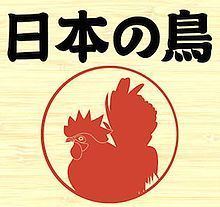13 Japanese Birds
(2009) Hiranya
(2009) Release date 2009 Label Important Records | Artist Merzbow Producer Merzbow Genre Noise music | |
 | ||
Released January 2009 – January 2010 Recorded October 2008 – November 2009 at Munemi House, Tokyo Length 721:56 (standard)
760:02 (Ecobag) Similar Somei, Don't Steal My Coat, Dolphin Sonar, Hiranya, Dead Leaves | ||
Merzbow fukurou 13 japanese birds pt 2 full album
13 Japanese Birds is a 15 album series by the Japanese noise musician Merzbow. It was inspired by Olivier Messiaen's Catalogue d'oiseaux (Catalog of birds), but has no direct musical relationship.
Contents
- Merzbow fukurou 13 japanese birds pt 2 full album
- Release history
- Suzume 13 Japanese Birds Pt 1
- Fukurou 13 Japanese Birds Pt 2
- Yurikamome 13 Japanese Birds Pt 3
- Karasu 13 Japanese Birds Pt 4
- Uzura 13 Japanese Birds Pt 5
- Kamo 13 Japanese Birds Pt 6
- Kujakubato 13 Japanese Birds Pt 7
- Kokuchou 13 Japanese Birds Pt 8
- Hiyodori 13 Japanese Birds Pt 9
- Niwatori 13 Japanese Birds Pt 10
- Shirasagi 13 Japanese Birds Pt 11
- Tsubame 13 Japanese Birds Pt 12
- Chabo 13 Japanese Birds Pt 13
- Jigokuhen
- Personnel
- Songs
- References
Release history
The series originally consisted of 13 albums released on a monthly basis from January 2009 to January 2010. They were also recorded one a month, and Masami Akita frequently revisited older recordings. It was also part of his then-recent return to live drums. Jenny Akita's cover art depicts illustrated birds on top of photographs. Each CD is limited to 1,000 copies.
The series was also available by subscription; as just the CDs, or with a custom-made bamboo box. Also available only with purchase of the box was an acrylic-on-bamboo painting by Akita himself.
In March 2010, Important released Ecobag/13 Birds in a Bag +1, this set included the original 13 CDs, a bonus CDR of additional material from the sessions, and a piece of original xerox art made by Akita in the mid-90s. All packaged together in a tote bag and limited to 200 copies. After the Ecobag sold out, the label released the Ecoblock or Bird Block in April 2012, with just the original 13 albums and a T-shirt.
In 2009, Important announced that an LP named Jigokuhen would be released to celebrate the completion of the series. Originally scheduled for the first anniversary of the completion of the original series (January 2011), but it was delayed until March. The album is the 15th and final volume of the Japanese Birds series, but is a stand-alone release.
Suzume: 13 Japanese Birds Pt. 1
The title refers to the sparrow (雀, suzume). "Tori Uta" was previously released as "<羽毛に纏わる水滴無限循環> Dedicated to アヒル (Duck)" on Zoundtrack by Ukawanimation!
Fukurou: 13 Japanese Birds Pt. 2
The title refers to the owl (梟, fukurō). "Gorosukehoukou" and "Noritsukehousei" are Japanese onomatopoeia for the sounds of owls.
Yurikamome: 13 Japanese Birds Pt. 3
The title refers to the black-headed gull (百合鴎, yurikamome, literally "lily seagull").
Karasu: 13 Japanese Birds Pt. 4
The title refers to the crow (鴉, karasu).
Uzura: 13 Japanese Birds Pt. 5
The title refers to the Japanese quail (鶉, uzura). The song titles refer to a March 2009 cull after the bird flu virus was found.
Kamo: 13 Japanese Birds Pt. 6
The title refers to the duck (鴨, kamo). The cover depicts the tufted duck. The first track is a protest against the wild-bird cull instituted by Tokyo Governor Shintarō Ishihara. Akasaka is a district in Minato, Tokyo.
Kujakubato: 13 Japanese Birds Pt. 7
The title refers to the Fantail pigeon (孔雀鳩, kujakubato, literally "peacock pigeon"). The bird design on the cover was previously used on Fantail. The album was delayed until the first week of August.
Kokuchou: 13 Japanese Birds Pt. 8
The title refers to the black swan (黒鳥, kokuchō). "Ushiwaka 2" is a reworking of a track from Yoshinotsune.
Hiyodori: 13 Japanese Birds Pt. 9
The title refers to the brown-eared bulbul (鵯, hiyodori).
Niwatori: 13 Japanese Birds Pt. 10
The title refers to the chicken (鶏, niwatori). The album was delayed until the first week of November due to printing errors.
Shirasagi: 13 Japanese Birds Pt. 11
The title refers to the egret (白鷺, shirasagi). The cover depicts the Asahi Beer Hall.
Tsubame: 13 Japanese Birds Pt. 12
The title refers to the barn swallow (燕, tsubame).
Chabo: 13 Japanese Birds Pt. 13
The title refers to the Japanese Bantam (矮鶏, chabo).
An unreleased work called "samidara1" was played during an event at ohrenhoch in Berlin, Merzbow described it as "using the method of several granular synthesis programs and random process of the composition.", and referenced Graft, Chabo, Jigokuhen, and Ouroboros as having the same concept.
天鵞絨の鳥
This is the bonus CDR that was included exclusively with the Ecobag, only 200 copies were made. It is also considered to be the 14th album of the series. Subscribers of the original series were able to download it from the label for free.
The album title transliterates to Tengajū no tori or Birōdo no tori and means "velvet bird". The track titles translate to "first song" and "second song".
Jigokuhen
Jigokuhen is an album released to commemorate the first anniversary of the completion of the original series (January 2011), but it was delayed until March. It is the 15th and final volume of the Japanese Birds series, but is a stand-alone release.
Personnel
Fukurou lists additional instrument credits:
Songs
1Red Bird of Summer - Part 119:42
2Fandangos in Space5:41
3Tori Uta6:24
